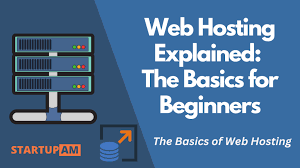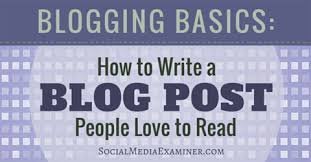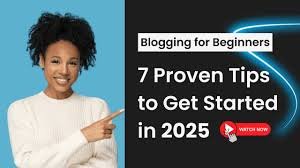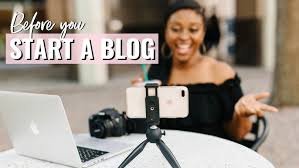Blogging has evolved into a powerful medium for self-expression, business promotion, and even a source of income. Whether you’re an aspiring writer, an entrepreneur, or simply someone who loves to share ideas, starting a blog can be a great way to get your voice out into the world. However, if you’re a newbie, the process of starting a blog can seem overwhelming. But don’t worry—this guide will walk you through the essential blogging basics to help you get started on the right foot.
1. Understand the Purpose of Your Blog
Before you begin creating your blog, it’s important to know why you’re starting it in the first place. Understanding your blog’s purpose will guide your decisions as you move forward. Here are some common reasons why people start blogs:
- Personal Blogging: Share your thoughts, experiences, and passions with others.
- Business Blogging: Build a brand, promote your services, or engage with customers.
- Creative Writing or Journalism: Showcase your writing talent and create an online portfolio.
- Monetizing: Use your blog as a platform for generating income through ads, affiliate marketing, or selling products.
By determining the purpose of your blog, you’ll have a clearer sense of direction, which will help shape your content and design.
2. Pick a Blogging Platform
When you’re ready to start your blog, one of the first decisions you’ll make is which blogging platform to use. Your platform will host your blog, allowing you to create and publish content. Here are a few popular options for beginners:
- WordPress.com: Great for beginners who want a simple setup without worrying about hosting. It’s free to start, but you can upgrade to a paid plan for more features.
- WordPress.org: Ideal for those who want complete control over their blog. You’ll need to buy hosting and a domain, but you can customize everything.
- Blogger: A free blogging platform from Google that’s simple to use but offers limited customization options.
- Wix: A drag-and-drop website builder that also allows you to start a blog. Great for people who want a more visual approach to designing their blog.
- Medium: Focused on writing and storytelling. Medium is simple but limits customization and control over your blog’s appearance.
For most beginners, WordPress.com is a solid choice. It’s easy to set up, and it offers everything you need to start blogging. However, if you want more flexibility and the ability to monetize your blog in the future, WordPress.org may be the better long-term option.

3. Choose a Domain Name and Hosting Provider
If you’re serious about blogging, you’ll want to have your own domain name (e.g., www.yourblog.com). This gives your blog a professional look and makes it easier for readers to remember your site.
Choosing a domain name can be a fun yet tricky task. Here are some tips:
- Keep it short and memorable: Short names are easier to remember and type.
- Make it relevant: Choose a name that reflects the content of your blog or your niche.
- Avoid numbers or special characters: These can be confusing and harder to remember.
Once you’ve chosen your domain name, you’ll need to purchase hosting for your blog. Many hosting providers offer one-click installations for WordPress and other platforms. Some popular hosting options include:
- Bluehost
- SiteGround
- HostGator
- WP Engine
Once you buy hosting, you can link it to your domain name, and your blog will be live on the web.
4. Design Your Blog
The design of your blog plays a crucial role in attracting and keeping visitors. A clean, visually appealing, and user-friendly design ensures that your audience will have a positive experience while browsing your content. Most blogging platforms, like WordPress, come with free themes that are customizable to suit your needs.
When designing your blog, here are some important considerations:
- Simplicity: A clean, uncluttered design makes it easier for visitors to navigate your blog.
- Mobile-Friendly: Many users will visit your blog on mobile devices, so make sure your blog’s theme is responsive and looks good on phones and tablets.
- Consistent Branding: Use colors, fonts, and images that align with your brand and message. This helps create a cohesive and professional look.
Remember, you don’t need to be a web designer to have a great blog. Start with a simple theme and make small improvements over time as your skills and understanding grow.

5. Create Engaging and Valuable Content
Now that your blog is set up, it’s time to create content. Writing great content is the heart and soul of a successful blog. Your posts should provide value to your readers, whether it’s through education, entertainment, or inspiration.
Here are some tips for writing engaging content:
- Write for Your Audience: Think about the people you’re writing for. What do they want to know? What are their pain points? Tailor your content to answer their questions and solve their problems.
- Use Attention-Grabbing Headlines: Your title is the first thing readers will see, so make sure it’s compelling enough to get them to click. Use power words, numbers, and keywords that pique curiosity.
- Be Consistent: Regularly update your blog with fresh content. Whether it’s weekly, bi-weekly, or monthly, consistency is key to keeping your readers engaged.
- Make Your Posts Scannable: Break up your text with subheadings, bullet points, and images. Most readers skim posts, so make it easy for them to find key information.
6. Optimize for SEO
Search Engine Optimization (SEO) is the process of optimizing your content to rank higher in search engine results. While SEO can be complex, even basic SEO practices can help your blog get discovered.
Here are a few essential SEO tips for beginners:
- Use Relevant Keywords: Research the keywords your target audience is searching for and use them in your titles, headers, and throughout your posts.
- Optimize Meta Descriptions: Write concise, engaging meta descriptions for each post. This is what shows up in search results and can influence click-through rates.
- Add Internal and External Links: Link to other relevant posts on your blog (internal links) and credible sources (external links) to improve SEO and provide additional value to your readers.
- Optimize Images: Compress your images to improve page load speed and include alt text for better SEO.

7. Promote Your Blog
Creating amazing content is only half the battle. To grow your audience, you’ll need to promote your blog through various channels:
- Social Media: Share your blog posts on Facebook, Twitter, Instagram, LinkedIn, and other platforms to drive traffic to your site.
- Networking: Connect with other bloggers and engage in blogging communities. Commenting on others’ blogs, joining forums, and attending webinars can help increase your visibility.
- Email Marketing: Start building an email list and send regular updates to your subscribers when you publish new content. This helps keep your audience engaged.
Conclusion
Starting a blog is a great way to express yourself, share your knowledge, and even make money online. By following these blogging basics, you’ll be well on your way to creating a successful blog. Remember, consistency is key. Focus on delivering value through your content, optimizing for search engines, and promoting your blog to grow your audience. With time and dedication, you can turn your blogging dreams into reality.
Related Tags:
- Blogging for Beginners
- How to Start a Blog
- Blog Tips for Newbies
- Blogging Basics
- SEO for Beginners
- WordPress Blogging
- Blog Promotion Tips
- Blogging Success Tips
- Content Creation Guide
- Start a Blog 2025













